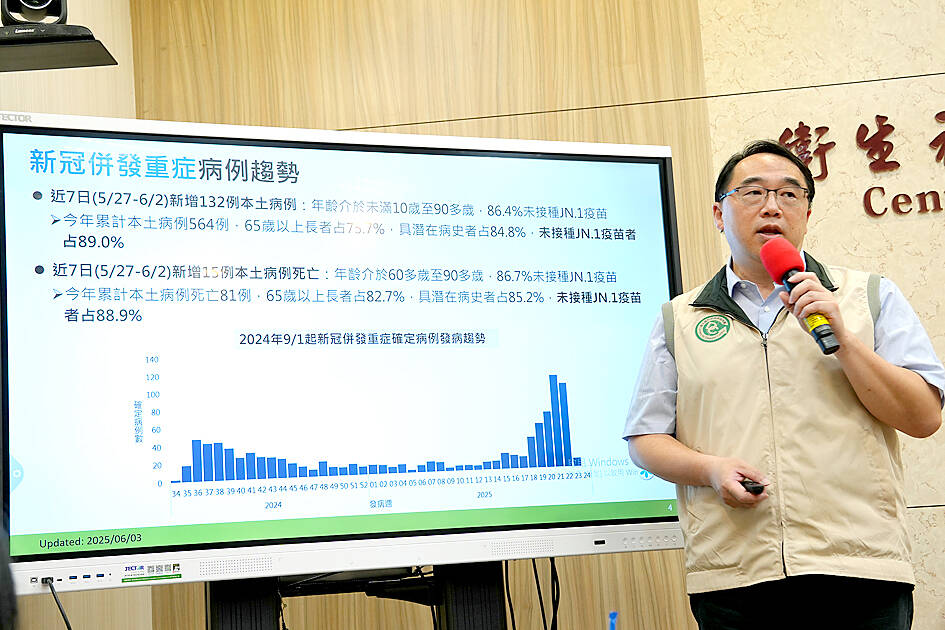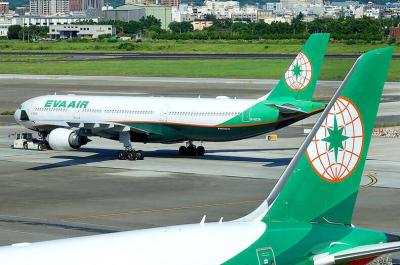The Centers for Disease Control (CDC) yesterday reported 62,755 hospital visits for COVID-19 and 132 hospitalized cases for last week, the highest weekly numbers this year.
Hospital visits for COVID-19 increased 49 percent last week, CDC Epidemic Intelligence Center Director Guo Hung-wei (郭宏偉) said.
A total of 132 people were hospitalized from Tuesday last week to Monday, and 86.4 percent of them had not got the JN.1-adapted vaccine, Guo said.

Photo: Chiu Chih-jou, Taipei Times
Of the 564 severe cases of COVID-19 this year, 75.7 percent are people aged 65 or older, 84.8 percent had underlying health conditions and 89 percent were not up to date on vaccines, he added.
The youngest hospitalized case last week was a five-month-old child, who did not have any underlying health conditions and was not old enough to get vaccinated, CDC physician Lin Yung-ching (林詠青) said.
The child was treated at a clinic for cold-like symptoms and later hospitalized after pulmonary infiltrates were observed on a chest X-ray, Lin said.
Fifteen deaths were reported in the past seven days, and they were aged 60 to 100, Guo said.
COVID-19 variant surveillance data show that NB.1.8.1 accounted for most local and imported cases in the past four weeks, he said.
As for COVID-19 activity in nearby countries, Guo said the number of cases in Malaysia and Singapore increased in the past few weeks, while it has slightly reduced in Hong Kong despite remaining high and slightly increased in Australia.
CDC Deputy Director-General Philip Lo (羅一鈞) said the centers’ projection of the domestic COVID-19 activity remains the same.
The current wave of infections is expected to peak late this month or early next month, with an estimated more than 200,000 hospital visits per week during the peak period, Lo said.
However, the slightly lower increase (49 percent) in weekly hospital visits last week could be because many clinics and hospitals were closed during the Dragon Boat Festival weekend, he said, adding that there could be a significant increase this week.
“This week is critical,” he said.
If the rate of hospital visits remains lower this week, the peak of the wave might not be as high as estimated, and the burden on the healthcare system would also be lighter than expected, he said.
The CDC encourages people to get vaccinated and wear masks in high-risk environments, he added.
Elderly people, pregnant women and those with underlying health conditions should do a rapid COVID-19 test when they develop respiratory symptoms, and seek medical care as soon as possible if they test positive to receive antiviral drugs, he said.
People who are not at high risk of developing severe complications from infection should also wear a mask in crowded places and seek medical attention at a clinic when they develop mild respiratory symptoms, he added.
Meanwhile, the CDC said 69 imported dengue fever cases have been reported this year as of Monday, which is the second-highest number in the same period in six years.
People should eliminate mosquito breeding sites to prevent dengue fever, especially during the plum rain season, it said.

EVA Airways today confirmed the death of a flight attendant on Saturday upon their return to Taiwan and said an internal investigation has been launched, as criticism mounted over a social media post accusing the airline of failing to offer sufficient employee protections. According to the post, the flight attendant complained of feeling sick on board a flight, but was unable to take sick leave or access medical care. The crew member allegedly did not receive assistance from the chief purser, who failed to heed their requests for medical attention or call an ambulance once the flight landed, the post said. As sick

A drunk woman was sexually assaulted inside a crowded concourse of Taipei Railway Station on Thursday last week before a foreign tourist notified police, leading to calls for better education on bystander intervention and review of security infrastructure. The man, surnamed Chiu (邱), was taken into custody on charges of sexual assault, taking advantage of the woman’s condition and public indecency. Police discovered that Chiu was a fugitive with prior convictions for vehicle theft. He has been taken into custody and is to complete his unserved six-month sentence, police said. On Thursday last week, Chiu was seen wearing a white

The Taichung District Court yesterday confirmed its final ruling that the marriage between teenage heir Lai (賴) and a man surnamed Hsia (夏) was legally invalid, preventing Hsia from inheriting Lai’s NT$500 million (US$16.37 million) estate. The court confirmed that Hsia chose not to appeal the civil judgement after the court handed down its ruling in June, making the decision final. In the June ruling, the court said that Lai, 18, and Hsia, 26, showed “no mutual admiration before the marriage” and that their interactions were “distant and unfamiliar.” The judge concluded that the couple lacked the “true intention of

EVA Airways, one of the leading international carriers in Taiwan, yesterday said that it was investigating reports that a cabin crew manager had ignored the condition of a sick flight attendant, who died on Saturday. The airline made the statement in response to a post circulating on social media that said that the flight attendant on an outbound flight was feeling sick and notified the cabin crew manager. Although the flight attendant grew increasingly ill on the return flight, the manager did not contact Medlink — a system that connects the aircraft to doctors on the ground for treatment advice during medical